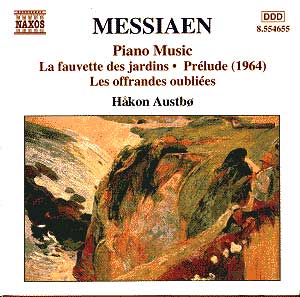This, the fourth volume of NAXOSís recordings of Messiaenís
piano music, focuses on a number of lesser-known pieces and on some
rarities from his sizeable piano output.
Thus, the piano version of Messiaenís first major orchestral
work Les offrandes oubliées (1930) was made at
the same time as the orchestral score, but does not seem to have attracted
much attention since. True to say that the piece works much better in
its orchestral guise, but the piano version, unsatisfying as it may
be, is still well worth hearing.
The Fantaisie burlesque, written in 1932,
is quite a curiosity indeed, for one would not readily associate Messiaenís
name with a piece attempting some musical humour. This lightish work
full of jazzy inflections is rather surprising, the more so because
of Messiaenís dislike of jazz. He even criticised Ravel for allowing
jazz rhythms and phrases in his G major Piano Concerto
and in LíEnfant et les Sortilèges. Though no great
masterpiece, it is an entertaining minor work.
The short Pièce pour le tombeau de Paul
Dukas was composed in 1935 (and not in 1953 as stated in the
otherwise excellent notes) in homage to Messiaenís teacher, whereas
the engaging Rondeau was written as a competition piece
for the Paris Conservatoire. The short Prélude
of 1964 (and published posthumously in 2000) is yet another curiosity
sometimes redolent of Satie in his Gothic mood.
La Fauvette des Jardins, completed in
1972, is a major work and a sizeable sequel to Messiaenís large-scale
cycle Catalogue des oiseaux. A tone poem in all but the
name, it evokes some Dauphiné landscapes from dawn to sunset
in vividly colourful tones in which birdsong inevitably has the lionís
share. It is a quite impressive achievement by any count, and one of
Messiaenís most readily accessible single piano works. I wonder what
it might have sounded like, had Messiaen decided to orchestrate it.
For all I can judge, Austbøís readings are excellent.
His piano playing has the tonal variety and the physical stamina required
by Messiaenís often taxing piano writing. He also possesses a vivid
imagination that serves him well in his fine reading of La Fauvette
des Jardins. A most welcome foray into Messiaenís lesser-known
piano works.
Hubert Culot


